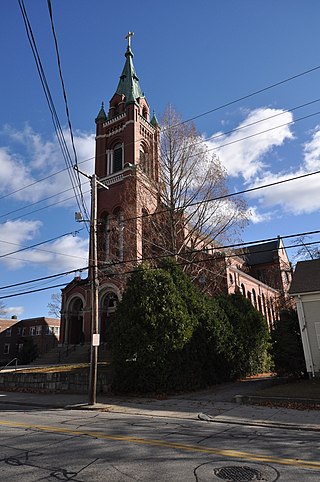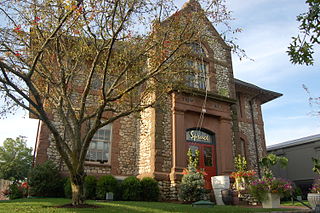
The Director's Quarters, Togus Veterans' Administration Center, previously known as the Governor's House, is a historic house on the grounds of the Veterans Administration (VA) facility in Togus, Maine. The house, built in 1869, is historically significant as the only surviving structure of the first National Home for Disabled Volunteer Soldiers, established at Togus in 1866 to serve American Civil War veterans. It was designated a National Historic Landmark in 1974. It is a contributing element of the historic district encompassing the Togus VA campus.

The Webster Grammar School is an historic former school building at 95 Hampshire Street in Auburn, Maine. Built in 1915-16 to a design by Harry S. Coombs, it was one of the first junior high school buildings in New England, and is a fine local example of Colonial Revival architecture. The building is now apartments and a community center, and was added to the National Register of Historic Places in September 2010.

The Wilton Free Public Library is the public library of Wilton, Maine, United States. It is located at 6 Goodspeed Street, across Wilson Stream from Main Street and just north of the town's central business district. It is located in the Goodspeed Memorial Library, an architecturally distinguished building designed by Harry S. Coombs, which was funded by Agnes Goodspeed and completed in 1916. The building was listed on the National Register of Historic Places in 1989.

The Fort Fairfield Public Library, located at 339 Main Street, is the public library of Fort Fairfield, Maine, United States. Fort Fairfield had a private library as early as 1880. It became a town-supported library in 1894 with a circulation of 300 books. In 1911 the town received a grant of $10,000 from Andrew Carnegie - making it one of the seventeen Carnegie libraries in the state of Maine. The building was designed by Lewiston architect Harry Coombs, and built by R.J. Noyes of Augusta. The Fort Fairfield Public Library was completed and officially opened on September 9, 1913.

George M. Coombs was an American architect in practice in Lewiston, Maine from 1874 to 1909.

Walter F. Fontaine was an American architect of French Heritage from Woonsocket, Rhode Island.

William R. Walker & Son was an American architectural firm in Providence, Rhode Island, active during the years 1881 to 1936. It included partners William Russell Walker (1830–1905), William Howard Walker (1856–1922) and later William Russell Walker II (1884–1936).
William Robinson Miller (1866–1929) was an American architect from Maine. He specialized in richly ornamented Romanesque- and French-Revival buildings. Born in Durham, Maine, Miller attended Bates College and the School of Architecture at the Massachusetts Institute of Technology (1891–1892).

Jefferson Lake Coburn (1835–1917) was an American architect in Maine. Many of his works were completed as a member of the architectural firm Coburn & Sons.

The Rumford Municipal Building is located on Congress Street in the central business district of Rumford, Maine. Built in 1915 to a design by Lewiston architect Harry S. Coombs, it continues to house the town's municipal offices today. It is a fine example of Colonial Revival architecture, representing the town's growth in the early decades of the 20th century, and was listed on the National Register of Historic Places in 1980.

The Strathglass Building is a historic commercial building at 25 Hartford Street in the central business district of Rumford, Maine. Built c.1906, it is an imposing four-story architect-designed Beaux-Arts building, constructed by Hugh J. Chisholm, Rumford's leading industrialist in the late 19th and early 20th centuries. Later known as the Hotel Harris, it was listed on the National Register of Historic Places in 1980.

Edwin E. Lewis (1846–1928) was an American architect from Gardiner, Maine.

William H. Stevens (1818–1880) was an American architect from Lewiston, Maine.

Ernest G. Southey was an American architect from Bridgeport, Connecticut.
Elmer I. Thomas (1863–1895) was an American architect who practiced in Auburn and Lewiston, Maine.

Addison G. Pulsifer was an American architect practicing in Lewiston, Maine.

Miller & Mayo, later Miller, Mayo & Beal, was a prominent architectural firm from Portland, Maine, established in Lewiston in 1907.
Miller & Beal, Inc., was a prominent architectural firm based in Portland, Maine, established in 1929. It was the successor to Miller, Mayo & Beal. Architect Lester I. Beal led the office.

Eugene J. Gibbs (1869–1929) was an American architect in practice in Lewiston, Maine, from 1896 to 1929.

Alonzo J. Harriman (1898–1966) was an American architect in practice in Lewiston and Auburn, Maine from 1928 to 1966.



























